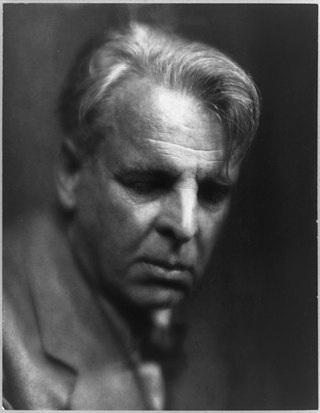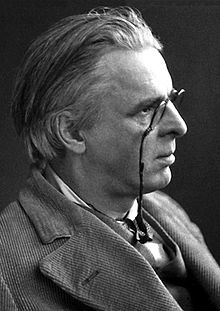
William Butler Yeats was an Irish poet, dramatist and writer, and one of the foremost figures of 20th-century literature. He was a driving force behind the Irish Literary Revival, and along with Lady Gregory founded the Abbey Theatre, serving as its chief during its early years. He was awarded the 1923 Nobel Prize in Literature, and later served two terms as a Senator of the Irish Free State.

"Ode to a Nightingale" is a poem by John Keats written either in the garden of the Spaniards Inn, Hampstead, London or, according to Keats' friend Charles Armitage Brown, under a plum tree in the garden of Keats' house at Wentworth Place, also in Hampstead. According to Brown, a nightingale had built its nest near the house that he shared with Keats in the spring of 1819. Inspired by the bird's song, Keats composed the poem in one day. It soon became one of his 1819 odes and was first published in Annals of the Fine Arts the following July. The poem is one of the most frequently anthologized in the English language.

The "Ode on Indolence" is one of five odes composed by English poet John Keats in the spring of 1819. The others were "Ode on a Grecian Urn", "Ode on Melancholy", "Ode to a Nightingale" and "Ode to Psyche". The poem describes the state of indolence, a word which is synonymous with "avoidance" or "laziness". The work was written during a time when Keats was presumably more than usually occupied with his material prospects. After finishing the spring poems, Keats wrote in June 1819 that its composition brought him more pleasure than anything else he had written that year. Unlike the other odes he wrote that year, "Ode on Indolence" was not published until 1848, 27 years after his death.
Daniel Albright was the Ernest Bernbaum Professor of Literature at Harvard and the editor of Modernism and Music: An Anthology of Sources. He was born and grew up in Chicago, Illinois and completed his undergraduate studies on a full scholarship at Rice in 1967. He received his MPhil in 1969 and PhD in 1970, both from Yale. Albright is also the author of the book Quantum Poetics which was published by Cambridge University Press in 1997. He held an NEH fellowship from 1973 to 1974, was a Guggenheim Fellow from 1976 to 1977, and more recently, he was a 2012 Berlin Prize Fellow at the American Academy in Berlin.

Helen Vendler was an American academic, writer and literary critic. She was a professor of English language and history at Boston University, Cornell, Harvard, and other universities. Her academic focus was critical analysis of poetry and she studied poets from Shakespeare and George Herbert to modern poets such as Wallace Stevens and Seamus Heaney. Her technique was close reading, which she described as "reading from the point of view of a writer".

Modernist literature originated in the late 19th and early 20th centuries, and is characterised by a self-conscious separation from traditional ways of writing in both poetry and prose fiction writing. Modernism experimented with literary form and expression, as exemplified by Ezra Pound's maxim to "Make it new." This literary movement was driven by a conscious desire to overturn traditional modes of representation and express the new sensibilities of the time. The immense human costs of the First World War saw the prevailing assumptions about society reassessed, and much modernist writing engages with the technological advances and societal changes of modernity moving into the 20th century. In Modernist Literature, Mary Ann Gillies notes that these literary themes share the "centrality of a conscious break with the past", one that "emerges as a complex response across continents and disciplines to a changing world".
"Sailing to Byzantium" is a poem by William Butler Yeats, first published in his collection October Blast, in 1927 and then in the 1928 collection The Tower. It comprises four stanzas in ottava rima, each made up of eight lines of iambic pentameter. It uses a journey to Byzantium (Constantinople) as a metaphor for a spiritual journey. Yeats explores his thoughts and musings on how immortality, art, and the human spirit may converge. Through the use of various poetic techniques, Yeats's "Sailing to Byzantium" describes the metaphorical journey of a man pursuing his own vision of eternal life as well as his conception of paradise.

Easter, 1916 is a poem by W. B. Yeats describing the poet's torn emotions regarding the events of the Easter Rising staged in Ireland against British rule on Easter Monday, April 24, 1916. The rebellion was unsuccessful, and most of the Irish republican leaders involved were executed. The poem was written between May and September 1916, printed privately, 25 copies, and appeared in magazines in 1920 but first published in 1920 in the collection Michael Robartes and the Dancer.

Sonnet 23 is one of a sequence of 154 sonnets written by the English playwright and poet William Shakespeare, and is a part of the Fair Youth sequence.

William Shakespeare's sonnet 116 was first published in 1609. Its structure and form are a typical example of the Shakespearean sonnet.

"Politics" is a poem by Irish poet William Butler Yeats written on May 24, 1938. It was composed during the time of the Spanish Civil War as well as during the pre-war period of Adolf Hitler's Third Reich in Germany. The poem hints at the political situations of "Rome" (Italy), "Russia", and Spain, but ultimately discusses topics more relevant to private human interaction rather than public, or political situations. The poem never mentions Germany or Hitler, despite the fact that the "war and war's alarms" surrounding the poem's creation arose from fears of Germany's aggression rather than Italy's, Russia's, or Spain's. Many versions of the text exist: the original typescript of May 1938, the first typescript with hand-written corrections dated August 12, 1938, as well as a final "Coole Edition" of the poem dated June 29, 1939, which was not published until it was included in Last Poems in 1939. Yeats intended for the poem to be printed last in the collection, as an envoi to "The Circus Animals' Desertion", and while a debate as to the true order of the poems has continued since 1939, "Politics" was the last lyric poem Yeats wrote and remains the final work printed in all posthumous editions.
"Down by the Salley Gardens" is a poem by William Butler Yeats published in The Wanderings of Oisin and Other Poems in 1889.
The volta is a rhetorical shift or dramatic change in thought and/or emotion. Turns are seen in all types of written poetry. In the last two decades, the volta has become conventionally used as a word for this, stemming supposedly from technique specific mostly to sonnets. Volta is not, in fact, a term used by many earlier critics when they address the idea of a turn in a poem, and they usually are not discussing the sonnet form. It is a common Italian word more often used of the idea of a time or an occasion than a turnabout or swerve.

Sonnet 71 is one of 154 sonnets written by the English playwright and poet William Shakespeare. It's a member of the Fair Youth sequence, in which the poet expresses his love towards a young man. It focuses on the speaker's aging and impending death in relation to his young lover.

"On being asked for a War Poem" is a poem by William Butler Yeats written on 6 February 1915 in response to a request by Henry James that Yeats compose a political poem about World War I. Yeats changed the poem's title from "To a friend who has asked me to sign his manifesto to the neutral nations" to "A Reason for Keeping Silent" before sending it in a letter to James, which Yeats wrote at Coole Park on 20 August 1915. The poem was prefaced with a note stating: "It is the only thing I have written of the war or will write, so I hope it may not seem unfitting." The poem was first published in Edith Wharton's The Book of the Homeless in 1916 as "A Reason for Keeping Silent". When it was later reprinted in The Wild Swans at Coole, the title was changed to "On being asked for a War Poem".

Sonnet 133 is a poem in sonnet form written by William Shakespeare, first published in 1609 in Shakespeare's sonnets.

In 1819, John Keats composed six odes, which are among his most famous and well-regarded poems. Keats wrote the first five poems, "Ode on a Grecian Urn", "Ode on Indolence", "Ode on Melancholy", "Ode to a Nightingale", and "Ode to Psyche" in quick succession during the spring, and he composed "To Autumn" in September. While the exact order in which Keats composed the poems is unknown, some critics contend that they form a thematic whole if arranged in sequence. As a whole, the odes represent Keats's attempt to create a new type of short lyrical poem, which influenced later generations.
"The Sea-Bell" or "Frodos Dreme" is a poem with elaborate rhyme scheme and metre by J.R.R. Tolkien in his 1962 collection of verse The Adventures of Tom Bombadil. It was a revision of a 1934 poem called "Looney". The first-person narrative speaks of finding a white shell "like a sea-bell", and of being carried away to a strange and beautiful land.

Blood and the Moon is a poem by Irish poet William Butler Yeats written in 1927. It was first published in the Spring 1928 issue of The Exile and then in the collection The Winding Stair in 1929, before being reprinted in The Winding Stair and Other Poems in 1933. Yeats composed the poem in response to the 1927 assassination of Kevin O'Higgins, the Vice-President of the Free State, whom Yeats had known personally. The poem contains many themes common in Yeats's poems from the 1920s including the "tower", a reference to Thoor Ballylee, which had been the title of a collection of works printed the year before "Blood and the Moon" was published, as well as the "gyre" which had been a major focus of his 1920 poem "The Second Coming".
Alexander Norman "Derry" Jeffares AM was an Irish literary scholar.













